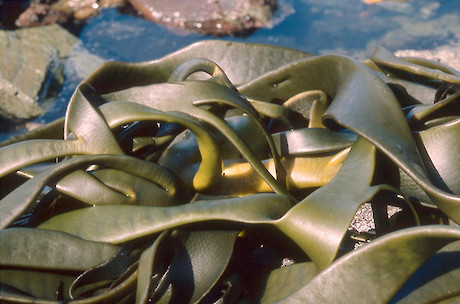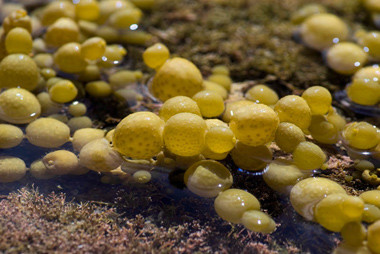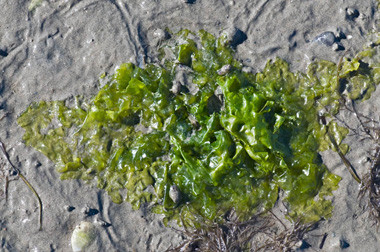 Bull kelp (Durvillaea antarctica). Photographer:Jeremy Rolfe.Macroalgae (or seaweeds) belong to three quite different groups of organisms. They are distinguished by their pigments and referred to as green, brown or red algae. As well as having distinctive pigmentation, the red, green and brown seaweed groups differ from each other in their storage products, cell wall chemistry, reproduction and life histories. These differences indicate that these groups of algae are not closely related but have very different evolutionary backgrounds.
Bull kelp (Durvillaea antarctica). Photographer:Jeremy Rolfe.Macroalgae (or seaweeds) belong to three quite different groups of organisms. They are distinguished by their pigments and referred to as green, brown or red algae. As well as having distinctive pigmentation, the red, green and brown seaweed groups differ from each other in their storage products, cell wall chemistry, reproduction and life histories. These differences indicate that these groups of algae are not closely related but have very different evolutionary backgrounds.
The marine macroalgal flora in New Zealand is conservatively estimated to be ca. 800 species (probable number closer to 1000 species). The current estimates are ca. 333 genera (80 browns, 43 greens, 210 reds) and ca. 835 species (165 browns, 130 greens, 540 reds).
Seaweeds vary enormously in their size, shape, and growth form. They can range in size from microscopic single cells (the red alga Porphyridium purpureum) through to huge kelps, such as Macrocystis pyrifera that can reach 20 metres in length, growing from massive holdfasts attached to rocks on the sea floor. There is great diversity in macroalgal growth forms and shapes - for example they can grow as cushions, crusts, blades, tubes, bladders, sheets, filaments, densely branched thalli. The texture of macroalgae ranges from diaphanous sheets, leathery blades, gelatinous thalli, and tough cartilaginous clumps. Some red algae are known as “corallines” - they have calcium carbonate in their cells walls and are very hard, growing either as crusts that are completely calcified or with uprights and calcified joints. Foreign marine algae have been introduced through shipping contacts since the early days of European contact with New Zealand.
 Neptune’s necklace (Hormosira banksii). Photographer: Jeremy Rolfe.
Neptune’s necklace (Hormosira banksii). Photographer: Jeremy Rolfe. Ulva sp. Photo by Jeremy Rolfe.Algae growing on the hulls of ships became established in port areas and while some of these foreign species spread others remained very restricted in their distribution, apparently posing little threat to the native marine flora and fauna. Over the past 20 years there has been increasing recognition of the risks associated with introduced species - and a greater understanding of the pathways by which introductions can occur. For more information about seaweeds see*:
Ulva sp. Photo by Jeremy Rolfe.Algae growing on the hulls of ships became established in port areas and while some of these foreign species spread others remained very restricted in their distribution, apparently posing little threat to the native marine flora and fauna. Over the past 20 years there has been increasing recognition of the risks associated with introduced species - and a greater understanding of the pathways by which introductions can occur. For more information about seaweeds see*:
- Adams, N.M. (1994). Seaweeds of New Zealand. Canterbury University Press. Pp.360. This is the standard reference book.
- Adams, N.M. (1997). Common Seaweeds of New Zealand. Canterbury University Press. Pp.96. This is a smaller popular version covering 100 common species.
- Farr, T.; Broom, J.; Hart, D.; Neill, K.; Nelson, W. (2009). Common coralline algae of northern New Zealand: an identification guide. NIWA Information Series, 70 (File size - 13.44MB)
- Harvey, A.; Woelkerling, W.; Farr, T.; Neill, K.; Nelson, W. (2005). Coralline algae of central New Zealand: an identification guide to common ‘crustose’ species. NIWA Information Series No. 57. 145 p. (File size - 8.43MB)
- Seaweeds (Te Ara Encyclopedia of NZ)
- Distribution patterns in NZ seaweeds by L.B.Moore (Tuatara, Vol 9: Issue 1)
- An annotated list of the brown seaweeds, Phacophyceae, of New Zealand by Victor W. Lindauer (Transactions of the Royal Society of NZ, Vol 76, Part 4)
*The Network is not responsible for the content of external internet sites
